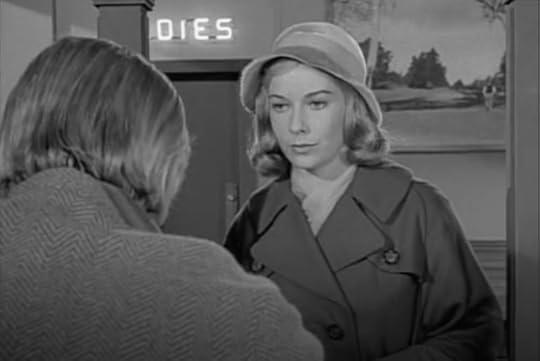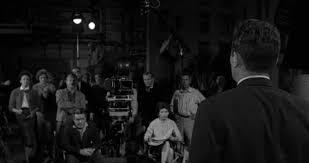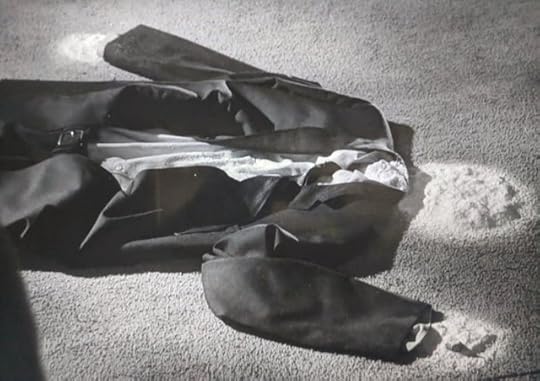July 16, 2024: Our Twilight Zone rewatch continues with episdoes 21-24!
Episode 21, “Mirror Image”
This episode was first telecast February 26, 1960.
Rod Serling got the idea for this episode from an incident where he spotted someone at an airport with the exact same height and build as him, wearing the exact same clothes, carrying the exact same briefcase. He imagined how creepy it would be if the guy turned around and – it was him! In the end, it turned out not to be him but, according to Serling, a younger handsomer version of himself. Still, a story idea was born.
The story resembles Anthony Armstrong’s short story/novel “The Strange Case of Mr. Phelam”, about a man who survives a car crash only to find himself stalked by his own doppelgänger. Alfred Hitchcock ended up purchasing the television rights for his Alfred Hitchcock Presents.
Jordan Peele, a life-long fan of the show, cites this episode as an influence on his movie, Us. The entirety of the episode was shot on Stage 25 on the MGM lot.
The chase sequence at episode’s end was achieved through the use of rear projection, having actor Martin Milner run in front of a screen projecting a shot of Milner running down the street in pursuit.
Vera Miles plays the part of the overwhelmed Millicent Barnes. Born Vera Ralston, the former Miss Kansas changed her name to Vera Miles because there was already a working actress named Vera Ralston working in Hollywood at the time she moved to L.A. Hitchcock cast her in an episode of his show and, impressed by her performance, dubbed her “the new Grace Kelly” and cast her opposite Henry Fonda in The Wrong Man, ultimately signing her to a 5-year deal. This was the same year John Ford cast her in “The Searchers.” Hitchcock cast her as Judy Barton in Vertigo but she had to bow out of the part due to pregnancy. She was originally cast as Mario Crane in Psycho while Janet Leigh was slated to play Lila Crane, but Hitchcock ended up reversing the roles. Vera Miles retired from acting in 1995 and remains, today, the longest surviving cast member of Psycho.
Actor Martin Milner who plays the helpful Paul Grinstead in this episode got his start in the business through a happy connection. Jack Webb, the creator of Dragnet, owed him money from a card game and when Milner swung by the studio to collect, Webb cast him in the Dragnet radio show. They formed a fast friendship and, soon after, Webb cast him in the role that would mark the high-point of Milner’s career: Pete Malloy on Adam-12. Before Adam-12, however, came Route 66, a ground-breaking road series that shot coast-to-coast and made Martin Milner a household name. Milners was apparently the visual inspiration for DC Comics’ Green Lantern Guy Gardner.
This one was a delightfully unnerving episode from the get-go. I’m sure you didn’t miss the framing of the “LADIES” room sign in an early shot that obscured the first two letters to read “DIES” behind Millicent as she inquires at the ticket booth. The episode does a beautiful job on exploring what would become a recurring theme on the show, the uncertainty of identity and its tenuous mooring to reality. As much as I loved the single setting, I thought the bus station was too small and underpopulated to believe neither Millicent nor the other occupants would have noticed the two Millicents crossing paths at some point. That medium-sized quibble aside, I really enjoyed “Mirror Image” and especially the ending. The sequence of Paul’s desperate attempt to keep up with his double is all the more unsettling for the fact his doppelgänger is actually smiling, suggesting malevolence at play. Creepy.
Episode 22, “The Monsters Are Due on Maple Street”
This episode was originally broadcast March 4, 1960.
“The Monsters Are Due on Maple Street” shares similarities with Raymond F. Jones’ “The Year When Stardust Fell”, a 1958 novel in which a comet’s passing precedes a worldwide cessation of machine function which eventually leads to mob rule.
The aliens at the end of this episode are wearing uniforms from Forbidden Planet. The Maple Street location of this episode would later be used in season 5’s “Stopover in a Quiet Town”.
Actor Claude Akins, who plays Steve Brand in this episode, enjoyed a busy 40 year career that included 100 films and over 180 t.v. episodes. He was General Aldo in Battle for the Planet of the Apes (1973) but is probably best known as the titular hero in television series The Misadventures of Sheriff Lobo. He was, by all fan accounts, incredibly gracious and friendly, always happy to honor autograph requests.
Actor Burt Metcalfe, who has a small role as Don Martin, was a casting director for Universal when he landed a producer credit on MASH. He worked his way up to Executive Producer, staying on for the show’s entire run, the only producer to do so.
Actress Anne Barton, who plays Myra Brand, was Eddie Haskell’s mom in Leave it to Beaver.
Actor Robert McCord, who plays the ice cream man in the opening scene, appeared in over 60 episodes of The Twilight Zone, mostly as an uncredited extra.
I think I’m experiencing my own Mandela Effect as I was sure I’d read this story in high school as part of a Ray Bradbury collection but, to my surprise upon researching the episode for this rewatch, I discovered this was an original story by Rod Serling. Anyway, this episode is clearly influenced by the Cold War mentality at the time and the paranoia-fueled McCarthy trials that sought to root out communists in everyone’s backyard. The episode does a nice job of ramping up the paranoia despite the occasional leaps in logic necessary for the story to work (ie – No one can walk down a couple of blocks to find out what’s going on. Well, no one can do so without getting shot and killed evidently.). The aliens at the end had a nice Kang and Kodos vibe, predating The Simpsons’ would-be-conquerors who would premiere 30 years later. This episode gets a lot of well-deserved love but I just found some of the mob assumptions just a tiny bit convenient at times. Overall though, great episode.
Episode 23, “A World of Difference”
This original broadcast date for this episode was March 11, 1960.
This episode would prove the inspiration (in some cases subconscious?) for an episode of Eerie, India, Mad About You’s “Up in Smoke”, Stephen King’s short story “Umney’s Last Case”, and the movie The Truman Show – among many others.
This episode was shot throughout the MGM Studios backlot including the famous Philadelphia Story house, built for the 1940 movie, that played as the exterior to Arthur Curtis’s suburban home.
Arthur’s decision to book a trip to San Francisco was a tip of that to actor Howard Duff who gained fame as Sam Spade in the The Adventures of Sam Spade, set in San Francisco. Duff was married to actress Ida Lupino who played the role of faded screen star Barbara Jean Trenton in Episode 4, “The Sixteen-Millimeter Shrine”. They were THE Hollywood IT couple at the time and co-starred in their own series, Mr. Adam and Eve, eventually divorcing after 15 years of marriage. One of Howard Duff’s last roles was as Paul Galveston on the series Knots Landing.
David White, who plays Arthur’s level-headed agent, Brinkley, is perhaps better known as Darrin Stephens’ boss, Larry Tate, on the television series Bewitched. He would appear in 191 episodes of the show, second only to series lead Elizabeth Montgomery.
Eileen Ryan, who plays the part of the nagging Nora Raigan, was the mother of actors Sean and Chris Penn, and musician Michael Penn.
Gail Kobe, who plays Arthur’s helpful secretary, Sally, became a producer for daytime soaps, eventually earning a position as an Executive Producer on The Guiding Light.
Susan Dorn, who plays Curtis’s wife, Marion, would, decades later, have her therapy license revoked after admitting that Nicole Brown Simpson had confided in her about the domestic abuse she had suffered.
Another interesting episode exploring the uncertain nature of identity. To be honest, I have very mixed feelings about this one. On the one hand, if you interpret it as a more traditional Twilight Zone episode, then poor family man Arthur Curtis was thrown a scare but managed to effect an 11th hour escape back to his reality. BUT, if your interpretation is the opposite, that the character we are following is, in fact, actor Gerald Raigan, then we are watching a man’s mental collapse and subsequent retreat from reality, a result of stress, excessive drinking, and the pressures of an overbearing wife. It’s really quite depressing. There are arguments to be made for both interpretations but what cinches is it for me is the final scene that takes place on the set, this time free of our protagonist’s POV, strongly suggesting that this is, indeed, reality. Like I said, depressing. While Arthur Curtis makes good his escape, Gerald Raigan’s breakdown is complete. Apparently, after the episode aired, more than a few people wrote in asking for an explanation of the ending. I’m interested to hear your interpretations.
Episode 24, “Long Live Walter Jameson”
This episode originally aired March 18, 1960.
The original title of this episode was “Forever and a Day”, but it was changed after production.
“Long Live Walter Jameson” was originally scheduled for a 3-day shoot, but the complexity of the aging sequence required an extra day of filming. Walter’s onscreen aging was achieved through the use of red color age make-up and red key lights. According to actor Kevin McCarthy: ““The ten or fifteen seconds on the screen when I age was done with red and green lines on my face. We shot the film in black and white with red and green filters. When we switched the color filters, the lines that were obscured appeared on the screen and it looks like I age without any special effects. The man who did the makeup on me that day told me when he did the same trick for Dr. Jekyll and Mr. Hydge, it cost the studio $5,000. Now he was doing it for The Twilight Zone and it was costing them $25,000!”
This episode was written by Charles Beaumont who would, ironically, pass away at the very young age of 39 due to early-onset-Alzheimers. In contrast, the cast of this episode lived exceptionally long lives.
The exterior of Jameson’s house is the same suburban home exterior glimpsed last episode, originally constructed for the 1940 film The Philadelphia Story. The living room interior and front door entrance were built for The Time Machine (1960) and repurposed throughout the show’s first season.
Actor Kevin McCarty who plays the titular character in this episode appeared in over 100 films, among them a starring role in the 1956 Invasion of the Body Snatchers. He was a distant cousin of reviled US Senator Eugene McCarthy.
Actress Estelle Windwood who plays the elderly, spurned former wife Laurette Bowen, made her final onscreen appearance as a guest star on a 1979 episode Quincy at age 96, making her the oldest working actor in the U.S. At age 95, she admitted to being a 3-pack-a-day smoker. She lived to 101.
I’m admittedly not as big a fan of the supernatural stories and even though this episode was more talky than most, I did enjoy the set-up, especially Walter’s admission that his is an actual living hell, watching those he loves grow old and die. Well, the ones he doesn’t abandon anyway. Again, you knew where this one was headed right down to the last dusty shot, but it delivered well nevertheless. I did find the “young” Susanna character…weird. Given her almost infantile behavior and deference to her father, I figured she was supposed to be 16 only she turned out to be 30 (!) which made her pending marriage much easier to swallow but still equally bizarre as Walter treated her like a daughter as well. I wasn’t married in the late 50’s/early 60’s, so I can’t say the relationship dynamics depicted in this episode are atypical, but boy did they leave me uneasy. What did you all think?
The post July 16, 2024: Our Twilight Zone rewatch continues with episdoes 21-24! appeared first on Joseph Mallozzi's Weblog.
Joseph Mallozzi's Blog
- Joseph Mallozzi's profile
- 39 followers







